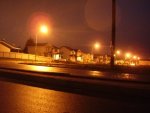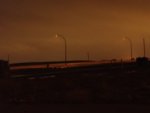The small town that we're in has historic looking lamp posts on most corners in town and space out about every 200' on the perimeter streets that have a high pressure sodium fixture mounted on top of a metal post that's probably about 12-14' off the ground.
Last year the town adopted a dark sky night initiative. Up to this point they haven't done anything regarding changing/retrofitting the fixture at the top of the post.
The way it appears to be set up is that a set number of lamps are controlled by photo-eyes with contactors located throughout the town. A number of the fixtures do not work, whether it's a problem with the control circuit/device, or a interrupted power supply to the fixture hasn't been diagnosed yet.
We're thinking the whole scenario is prime for a proposal to the city to upgrade their lighting to be darky sky compliant and fix a lot of their current issues.
Problem is I don't know a ton about being dark sky night compliant other than a little bit of info on the web. Also trying to learn what I can about retrofitting the current posts with a compliant fixture and tracking down a supplier.
If anyone has experience with this situation I'd be grateful for any advice.
Thanks,
Sky
Last year the town adopted a dark sky night initiative. Up to this point they haven't done anything regarding changing/retrofitting the fixture at the top of the post.
The way it appears to be set up is that a set number of lamps are controlled by photo-eyes with contactors located throughout the town. A number of the fixtures do not work, whether it's a problem with the control circuit/device, or a interrupted power supply to the fixture hasn't been diagnosed yet.
We're thinking the whole scenario is prime for a proposal to the city to upgrade their lighting to be darky sky compliant and fix a lot of their current issues.
Problem is I don't know a ton about being dark sky night compliant other than a little bit of info on the web. Also trying to learn what I can about retrofitting the current posts with a compliant fixture and tracking down a supplier.
If anyone has experience with this situation I'd be grateful for any advice.
Thanks,
Sky




